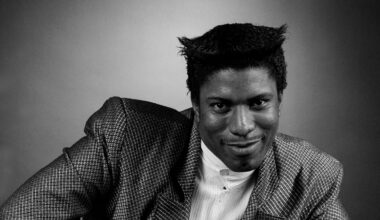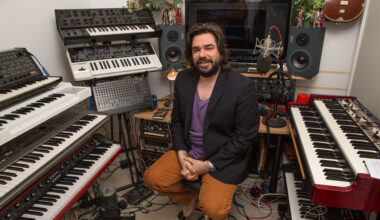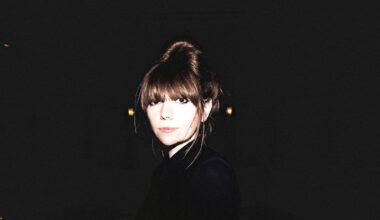Having dabbled with electronics previously, Jane Weaver has gone the whole hog on her new album and fully embraced the synthy goodness. We discover the thinking behind her new winning formula…
“If you can’t be free as a musician, when can you be free?” says Cheshire-via-Manchester psyche-synth seer Jane Weaver, talking about the musical departure of her new record. “You should be able to do what you want. That’s why I like to change now and again, expand what I’m doing, even if it makes me feel uncomfortable.”
Jane’s latest record, the follow-up to 2014’s ‘Silver Globe’, is another reinvention. ‘Modern Kosmology’, her seventh solo offering, is a dream-like mix of burbling analogue synths, chugging guitars and highly memorable songs. She’s fed a love for 1970s kosmische and 1980s new age electronics through a hooky pop filter, and it’s superb: the latest work from an artist who insists on challenging herself and following her artistic muse.
Chatting on the phone, she is down-to-earth and happy to tell us about the background of the new record. Her lyrics, music and philosophies, though, betray a mind fascinated by astral atmospheres, and states of being beyond the typical. From the way she writes her songs, which appear to her as fully formed pieces, to her interest in psychic channelling through art, Jane’s brain is at least partly attuned to the cosmos.
“Songs are thrown into your head,” she says. “It’s weird, like, ‘What’s this?’, I have no idea why it happens and I’m always interested in how other people create, and whether they get their ideas in that way, or how they remember ideas. It’s really interesting. Maybe I’ve just done too much acid, I don’t know!
“It’s like a storyboard sometimes, like I’m building a little film in my head as to what those songs are, and then parts of the chorus have certain visuals about them. I’ve always been a daydreamer, so maybe it’s part of that. I’ve got quite a visual imagination.”
In her teenage years Jane got her break playing guitar music on the pub circuit. At 19, she signed a record deal with her band Kill Laura, releasing several singles and EPs of indie jangle (championed by John Peel) and Britpop hooks on labels Klee and Manchester Records. In 2001, she released the first of several records with Misty Dixon, a folk and electronica influenced group, through her own Bird Records (an offshoot of Twisted Nerve).
Over the course of her seven solo albums, this prolific artist has made indie pop, electronic-tinged folk and, on her last record, the deservedly hyped ‘Silver Globe’, a unique take on krautrock. Hypnotic sounds and celestial moods have long been an obsession, and have manifested themselves on tracks such as the swirling, enrapturing ‘Mission Desire’ (from ‘Silver Globe’) or on her collaborations with electronic music pioneer Suzanne Ciani. ‘Modern Kosmology’, though, represents a complete embrace of the synth sounds that until now had only been an irregular feature of her songs.
“I’d use a Mini Moog when I’d go in the studio,” Jane says. “But now I’ve bought a Juno 6 and I was using that, a Korg Poly Ensemble, a Roland guitar synth, and a Roland string synth. Those are key instruments now.”

It’s the fact that these synths have a life and history of their own, and that their sound is subtly altered each time they’re switched on that intrigues her.
“I do like the fact that when you go into the studio, somebody else has been previously using it, and then you plug it in and it’s got a different sound from when you first used it. It’s like this chain letter of sound, and it’s a historical thing as well. In this studio I use, the guitar synth was once owned by Status Quo!”
The opening track on the new album, ‘H>A>K’, is a frenetic thrum of motorik beats and vibrating analogue squelch merged with Jane’s crystalline voice, while ‘Did You See Butterflies?’ is a haunting earworm of distorted guitar riffs and electronic oscillation, a pop song wrapped in psychedelic textures. Similarly, single ‘Slow Motion’ is a space lullaby, an ode to escape with a phalanx of spiraling synths surrounding Jane’s vocals. It’s the most beautiful song she’s made, and a perfect illustration of her meld of pop accessibility and sounds you wouldn’t necessarily associate with a pop song.
“I’m not massively avant-garde and experimental,” she explains. “I like pop music as well, so my stuff is more song-based. I was doing more guitar-based stuff, and then I got bored with that. I was just looking for other ways to create, and using more synths and electronic sounds. I’ve always been a fan of new age music and the amazing synth sounds of the 70s and 80s. They are just so powerful, they give you a certain feeling.”
The influence of 1970s music is evident on ‘Modern Kosmology’ in other ways too. ‘Loops In The Secret Society’ and ‘H>A>K’ are distinguished by their endless propulsive rhythm, a beat that doesn’t deviate and hypnotises with its repetition. The motorik rhythms of German space rock and the infinite drums of Neu! or Harmonia are, Jane says, a definite source of inspiration.
“It’s like a heartbeat,” she agrees. “I always liked the first track of albums to be something quite strong. With this album that heartbeat sound: pulsating, heavy, is from the Mini Moog,
“If you pull a song out of something that maintains the same rhythm, the same chords, the same keys, and has only certain nuances in it, I think it’s a challenging thing. We can all do chord changes, we can all do middle eights, we can all do certain things to change a song to take it to a different place, but sometimes it’s nice to have this pulsating thing all the way through.”
Another profound connection to the great German musical innovators of the 1970s is in ‘Dust’, a collaboration with Can mystic Malcolm Mooney, the American vocalist who appeared on their first albums ‘Monster Movie’ and ‘Delay 1968’, and the later records ‘Soundtracks’ and ‘Unlimited Edition’. A meditative piece with Malcolm telling us, “We’re on our way / to dust”, it unspools into a valley of guitars, violins and trippy atmospherics. A long-time friend, Jane persuaded Malcolm to lend his vocals to the track when he was over in the UK for a festival appearance.
“Malcolm is a friend we’ve known for years through my husband Andy Votel [the producer and label owner behind the Finders Keepers and Twisted Nerve labels]. I was doing something and I couldn’t put my finger on what it reminded me of. Maybe it was an early Can soundtrack, which was a bit weird. Then I thought it would be nice to do something with Malcolm. He came over to the UK last year for Festival No.6 and I managed to get him for a couple of hours and go through everything, so it worked out fine.”
The musical inspirations of ‘Modern Kosmology’ are not only of the retro variety. In Jane’s vocal delivery and in the effortless merging of sounds, there’s a hint of Stereolab, something she’s only too happy to admit to.
“Laetitia Sadier is a friend,” she says. “Stereolab are definitely an influence, Broadcast too. It’s stuff I’ve always listened to, they’re part of my record collection. That’s good stuff! Why wouldn’t you take inspiration from that?”
Jane’s love of art is a less apparent influence upon the new album. A voracious consumer of art books, she recently discovered the little-known-but-very-ahead-of-her-time artist Hilma af Klint, whose methods of creating were drawn from the supernatural realm.
“She was Swedish and one of the first abstract artists,” Jane says. “People think Kandinsky and Mondrian were the first, but she preceded them. She had her own secret society in the early 1900s. She was a trained painter and she went off-road, decided to do all these weird, abstract geometric print paintings. And she channeled energy through séances and did automatic painting, painting for days exhaustively. It’s an amazing story, but people don’t really know about her because she stipulated she didn’t want people to see her work until 20 years after she died.”
The idea of Hilma’s spiritual channelling appealed to Jane, who sees a parallel in the way her songs arrive in her own brain, fully formed.
“The influence is séance and obviously automatic drawing, free association and the interest in where our ideas come from, and how other people get their ideas. I was influenced by her lyrically, and also trying to imagine where I was receiving my ideas from.”
Having explored various other genres in her work, it’s seems that the interplay between live instruments and synths heard on her most recent albums that suit her the most, just don’t try to guess what her next musical metamorphosis will be…
“There aren’t many areas in life when you’ve not got boundaries,” she concludes. “You’ve got to be more free.”
‘Modern Kosmology’ is out on Fire Records





